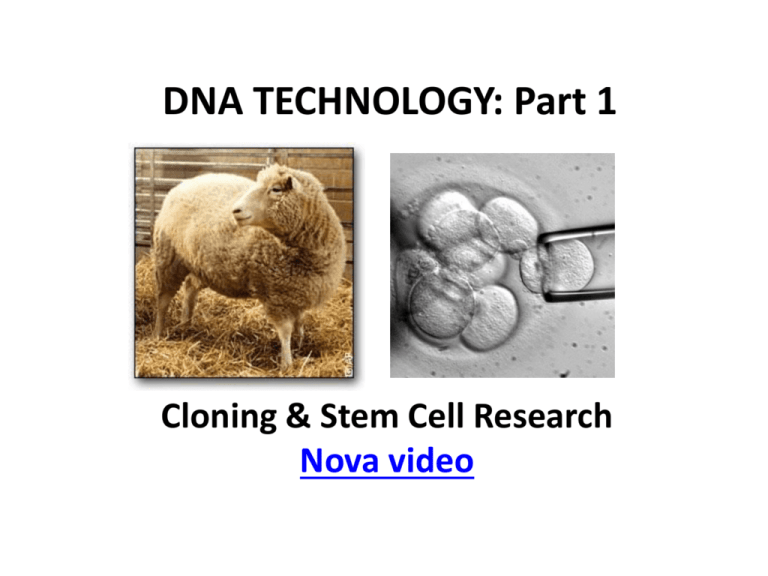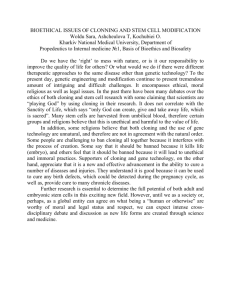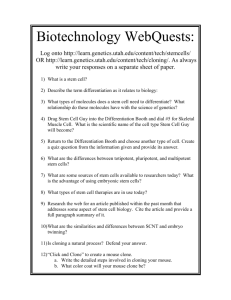Stem Cells and Cloning
advertisement

DNA TECHNOLOGY: Part 1 Cloning & Stem Cell Research Nova video What is a stem cell? •Embryonic stem cell – An undifferentiated cell derived from embryos that have been fertilized in vitro and then donated for research. Not derived from eggs fertilized in a woman’s body. •Adult stem cell – An undifferentiated cell found in a differentiated tissue that can give rise to all the specialized cell types of the tissue from which it originated. Not controversial. •Undifferentiated cells are not yet specialized – they can become different types of cells. Not all stem cells are created equal •Totipotent stem cells – can give rise to all types of tissue, i.e. an embryo •Pluripotent stem cells – can give rise to most, but not all, tissues of an organism, i.e. inner mass cells •Multipotent stem cell – give rise to cells that have a specific function, i.e. blood stem cells *Potency = ability to differentiate What is a blastocyst? Is a blastocyst a human? Princeton University University of Wisconsin-Madison Where do stem cells come from? Human embryos (embryonic) In Vitro Fertilization (IVF) since late 70s Currently 4 million IVF babies alive Often creates extra embryos (~400,000 unregulated frozen embryos in U.S.) Somatic cells (adult) Cells are “reprogrammed” to be pluripotent What’s cloning and how is it related? • Therapeutic cloning (stem cell therapy)Duplicating part of a person/organism e.g. a heart or liver, or even just a few cells. • Reproductive cloning- Duplicating an organism e.g. identical twins. •Therapeutic cloning can be patient-specific (cells from patient put in donated egg)! •Resulting cells would be a perfect match •Could treat many diseases (i.e. diabetes) as body would not reject cells as foreign •Experts warned that there was a risk the cells could become cancerous. Are there Human Clones? •Natural twins - just after fertilization a zygote divides into a twocelled embryo. Each cell continues to divide, producing 2 individuals. •According to new research, though identical twins share very similar genes, they ARE NOT identical (environmental & epigenetic factors) •Epigenetic (chemical) markers that turn genes on and off. Accumulate due to diet, smoking, etc. Can cause diseases like cancer and influence behavioral traits Artificial Twins: Artificial Embryo Twinning • Occurs in a Petri dish instead of in the mother's body. • Manually separating an early embryo into individual cells, and then allowing each cell to divide and develop http://www.abpischools.org.uk/resources/poster-series/images/clon02.png Artificial Twins: Somatic Cell Nuclear Transfer • Different approach than artificial embryo twinning, but it produces the same result: an exact clone of an individual. (Roslin Institute http://www.roslin.ac.uk/library/) The SCNT Animal Clone: Dolly •Nucleus of a sheep’s egg with the nucleus of a cell from a sheep’s udder. •SCNT produces live offspring less than 1 in every 100 attempts •Dolly was born in 1996 and euthanized in 2003 after developing progressive lung disease •Agricultural value (Roslin Institute http://www.roslin.ac.uk/library/) Cloning & Stem Cell News • • • • • • • • • • • 1996 – Dolly born 1998 – First experiment with human stem cells 2001 – Bush restricts federal funding for embryonic stem-cell research 2002 – First cloned cat 2004 – Researchers grow stem cells from embryos using private funding 2005 – South Koreans exposed for lying about creating 1st human clone 2006 – Scientists discover method to extract stem cells without destroying embryo (this may skirt “when does a human become a human” issue) 2007 – Human skin cells transformed into cells that look and act like embryonic stem cells (however, process may cause increased risk of cancer) 2007 – A mouse was cured of sickle cell anemia using stem cells 2009 – Obama overturns stem cell ban & offers federal funding for embryonic stem cell research, but opposes human cloning 2009 - Frozen skin used to clone a subspecies of ibex that went extinct in 2000 (Jurassic Park is still not a reality – no appropriate surrogate mothers for long-dead species) In small groups generate two lists: 1. The potential uses and benefits of cloning (therapeutic and reproductive) 2. The potential problems and arguments against cloning (therapeutic and reproductive) – Use your notes from the video and be prepared to share with the class Potential uses and benefits of cloning (cells and organisms) • Replacing organs and other tissues • Treat a variety of conditions (Parkinson's disease, burns, heart disease, diabetes, arthritis, etc.) • Understanding what causes cells to become “sick” • Infertility • Replacing a lost child • Creating donor people • Gene therapy • Saving endangered species Problems/arguments against cloning (cells and organisms) • • • • • • • Low success rate (Dolly took 276 attempts) Tumors & genetic defects Pre-mature aging (genetic age) Massive quantities of human eggs required Less genetic variation Lack of knowledge Value of life (blastocyst)




